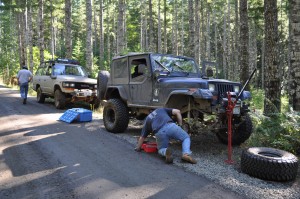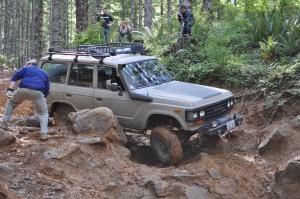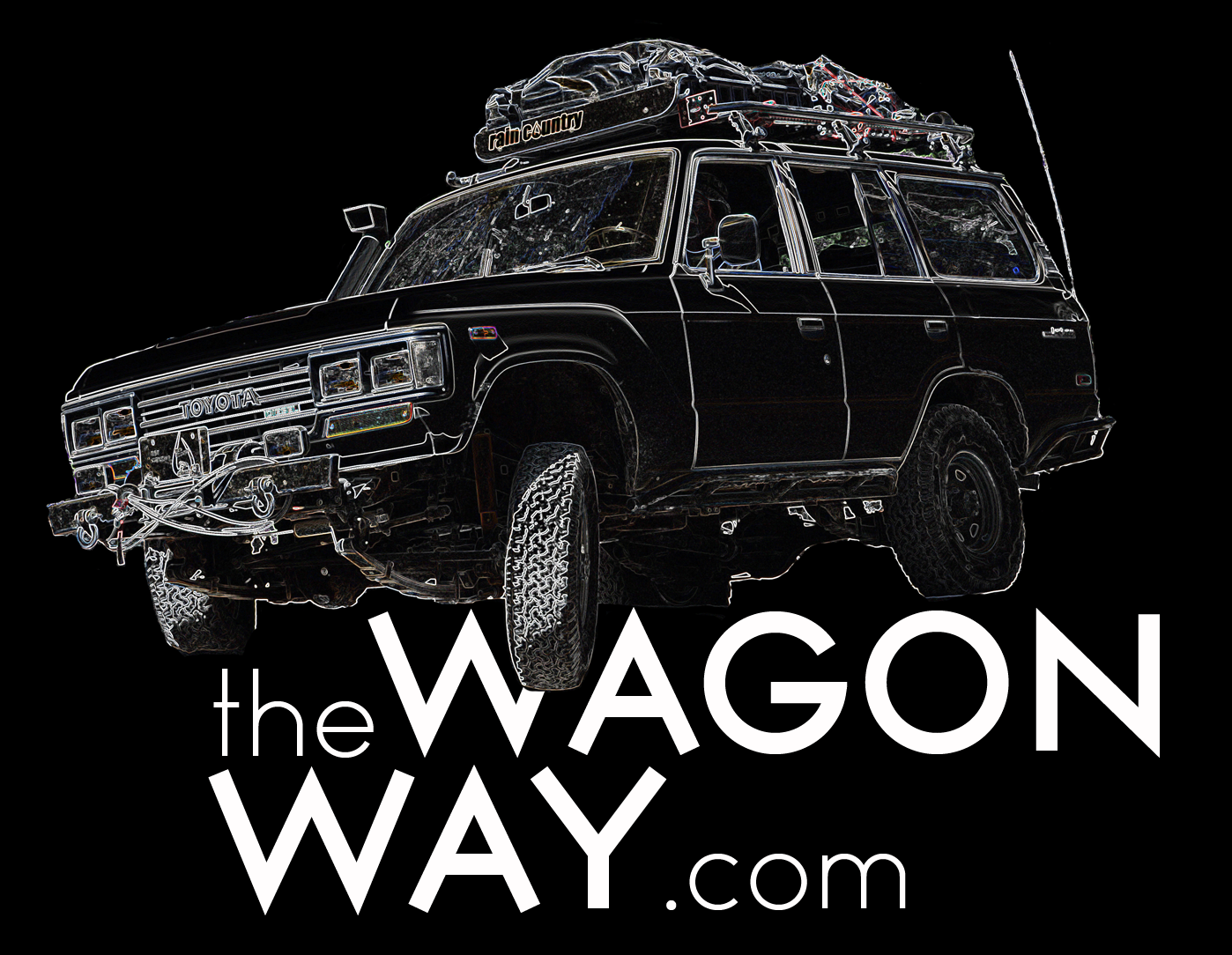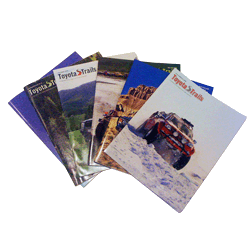By Tony and Eric
Not that we are all dummies, this is just stuff we have picked up on runs and thought it was worth sharing with others. New guys don’t know a lot of this stuff and it doesn’t hurt the old hands to be reminded about it once in awhile.
![]() –At the Trail head-
–At the Trail head-
Some things go without saying but others need to be mentioned. Use the time at the trail head wisely. Sure it’s a great time to catch up and BS, but you should also use it to prep for the the day’s run. Make sure everything is tied down and secure, air down your tires now not later, lock your hubs and start your compressor for your lockers. Turn on your CB to the day’s channel. An easy way to set the channel for the day is to use the date if possible (picked this one up from Cascade Cruisers).
Find out where you are needed for the day’s run, whether it is to lead the group or bring up the rear as the all important tail gunner. Introduce yourself to your fellow wheelers if you don’t know them already and share level of experience and skill. Mind you this is not to boast, but it is important for everyone to know if you may need help on the run, or if you can be the helper. Be aware of and pay attention to the trail leader.
-Trail Etiquette-
Just what the name implies, this is how you should behave once you are on the trail. The golden rule in our book, don’t leave your fellow wheelers behind. This rule pretty much applies all the time, if you can’t see the rig behind you stop until you can. No matter where you are in the group, whenever you make a turn and  there are rigs behind you, stop at the turn if you can’t see them. If they don’t see you turn they may miss it and who knows where they will end up. Even worse they could be stuck or broken and might need assistance. No one gets left alone in the woods As long as everyone follows this simple rule no one gets lost and if you do get lost it is as a group. Then you all get to laugh at your trail leader for not knowing the way.
there are rigs behind you, stop at the turn if you can’t see them. If they don’t see you turn they may miss it and who knows where they will end up. Even worse they could be stuck or broken and might need assistance. No one gets left alone in the woods As long as everyone follows this simple rule no one gets lost and if you do get lost it is as a group. Then you all get to laugh at your trail leader for not knowing the way.
A CB is almost mandatory these days. We have just found it to be the easiest way to communicate with all the rigs on a run. They are cheap and easy to install and on countless occasions they have helped put the group back together.
If your CB doesn’t work properly don’t try to lead. The trail leader for the day needs to be able to communicate with as many of the rigs as possible, and most importantly with the tailgunner. If you don’t have a CB be sure to get between rigs that have a working radio.
If you do lead you should know the area and where you are going. Have a good map if you are unsure and be sure to share extra’s with anyone who doesn’t. And who doesn’t want some idea of where they are going. In addition to the paper map a GPS is a great tool to have, some work better than others but often you can back track if you get lost or have to finish up in the dark. Fun to mess with even after you are done once you download your route to your computer.
Don’t leave anything behind, even bring home some extra trash if you can. Carry a map and be ready to spot. Recently on a run with about 10 rigs the only two people spotting were my buddy Kevin and I. Don’t be shy any one can spot.
Don’t crowd the rig in front of you, wait for them to get off the obstacle before you try to tackle it. Watch for reverse lights…
 Offer assistance to any one you see alone on the trail. Welcome stragglers and lost souls into your group. I don’t know how many times I have picked up extra rigs on a run, for the most part wheeling as a group is a lot more fun and safer too. Met some great folks this way as well.
Offer assistance to any one you see alone on the trail. Welcome stragglers and lost souls into your group. I don’t know how many times I have picked up extra rigs on a run, for the most part wheeling as a group is a lot more fun and safer too. Met some great folks this way as well.
-Know Your Limits-
You’re the driver. You know your limits and your vehicle’s limits, no one else does. There are times to push your skills and limits, and there are times not to. Be smart and know when those times are. You not only can break your rig or hurt yourself, but you can hurt someone else and/or least of all cut everyone’s wheeling trip short. If your spotter says you can do it and you do not feel comfortable, stop and re-assess the situation and come up with a plan that meets your level of wheeling. Wheel smart, have fun and most importantly be safe.
Along the same lines, don’t try to go wheeling with a group that doesn’t have the same idea for the day that you do. It’s important that the run is tailored to just who is on the run. A bunch of rock buggies don’t mix well with a stock rig. This is where a good trail leader is essential. And a responsible trail leader won’t take a bunch of new guys way beyond their limits.
-Communication-
This is a big safety issue. And not just having a radio but verbal communication with others in the group. If you see or hear something be sure to let the driver or spotter know. Sometimes rocks and damage is unavoidable, but as a driver I sure like to know it’s coming.
Be aware of your surroundings, watch for people on the ground, drivers and passengers. Listening is just as important as talking. Be loud when necessary. Stop is a good word. So is don’t stop. Make sure everyone is on the same page.
![]() Good Spotting-
Good Spotting-
Try and be familiar with all the rigs on a run. Not easy, but well spent time at the trailhead makes this simpler on the trail. Wagons bang and smash in ways that an FJ40 doesn’t. And yes you will get used to it (at least the guys who wheel with our wagons have). Frequently though you will get sucked in to spot a rig you are unfamiliar with, don’t worry, just ask the driver what he is looking for. You are the eyes for what he can’t see. If not sure just ask for someone with more experience at it. As I always tell my spotter, it’s my decision to keep moving. Much of a spotters job is saying when to stop.
-Winch Safety-
We cannot over emphasize just how important it is to be safe during a winch operation. Getting hurt is a distinct possibility if safety is not the first concern. Try and plan out the entire recovery if possible, such as who is going to![]() pick up the loose cable to prevent a rig running over it. Wear gloves if you are working with cable. Keep back a safe distance during a pull. And there should not be anyone in the rig being pulled except the driver.
pick up the loose cable to prevent a rig running over it. Wear gloves if you are working with cable. Keep back a safe distance during a pull. And there should not be anyone in the rig being pulled except the driver.
There is only one boss during a winch recovery, make sure all involved listen to him or her. Sometimes it is the driver and other times it’s someone outside of the rig being pulled.
Everyone has eyes, use them to look at what the boss can’t see and let them know what you see. Same goes for your ears. Anyone can and should stop a pull if they see something out of place.
Remember not to stand in the bight of a pull and always use a tree strap. It’s a good idea to check and make sure that all the rigs in your group have good tow points. More of that well spent time at the trailhead.
Taking kids along can be a whole lot of fun. Watching how kids react to what happens on runs and how they amuse themselves can very entertaining as well. But this also brings on the added challenge of maintaining awareness of just where all the kids are, and not just your own. Remember that kids are curious and don’t always listen. Nor do they know where to stand to be in a safe place. So don’t hesitate to tell my kids (or other kids) to move if they are in a bad place. While it would be nice to use a leash, most people would not approve.
And it’s not just barking at them that is needed. There will be times when Dad (or Mom) needs to focus on an obstacle and knowing you can count on your fellow wheelers to watch the kids for a moment or two is a big relief. As a family oriented club all the guys we tend to wheel with keep an eye on the kids when needed. Keep the kids safe and everybody has a good time. And it won’t be long before they want to take the wheel….
-Safety Checklist and Essentials-
Pretty much the generic one everybody seems to use but with a few key additions. Spare tire, tools, shovel, First Aid kit, fire extinguisher, a CB that works, hi-lift jack, tree strap and tow strap with shackles. Batteries must be securely fastened down.
Other items to check include making sure your horn works and you have good brakes including the parking brake. Have extra water, for drinking and the radiator. Include a spill kit for trailside messes as well as some sort of hand cleaner. But most importanly, patience, a willingness to help out and a good sense of humor.

